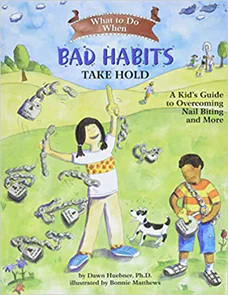What To Do When Bad Habits Take Hold
A Kids Guide to Overcoming Nail Biting and More
Written by Dawn Huebner, Ph.D.
Illustrated by Bonnie Matthews
72 pages
•
Published 2008 (Magination Press)

Recommended Age Range: 1st grade through 5th grade.
Publisher's Summary:
Nail biting. Thumb sucking. Hair twirling. Scab picking. Shirt chewing. Do you have a habit that’s hard to stop? A habit that embarrasses you or gets you in trouble? If so, you’re not alone. Lots of kids have habits they wish they could lose. But habits are stronger than wishes. They lock on, holding you tight. Even if you want to break free, you can’t. Unless you have the keys. What to Do When Bad Habits Take Hold provides the keys to escape from a variety of pesky habits… This interactive self-help book is the complete resource for educating, motivating, and empowering children to set themselves free.

Dr. Annie's Takeaways
Recommended for: This interactive workbook is a must-read for a child who is struggling with a body-focused repetitive behavior such as nail-biting, hair-pulling, skin-picking, lip-chewing, nose-picking, or thumb-sucking and who wants to stop. Children often develop shame about these behaviors and can’t stop despite caregivers’ frequent urging. This workbook is super destigmatizing–in fact, it explains to children why it makes sense that they feel the urge to do these things. It then presents five “keys”–very doable, evidence-based behaviors–that children can use to start new habits that will make the old ones obsolete. This book can be used in therapy sessions, as therapy “homework” between sessions, or at home with a caregiver.
Would a child like it? This workbook will be much preferred to a caregiver repeatedly reminding a child to stop biting their nails, etc. It’s a practical book rather than an entertaining story, but it holds the promise of a child being able to stop an unwanted habit.
Evidence-Based Practices:
Behavior Therapy
Tone: Encouraging, empowering
Story Quality: This workbook is super clear, validating, and encouraging. It lays out five “keys” that kids are encouraged to do everyday until the new behaviors turn into good habits. I love how the author, Dr. Dawn Huebner describes psychological concepts to kids–she’s just so good at explaining things with the right amount of detail and without talking down to children. There are interactive components to this workbook, which include a handful of little decoding word games, but mostly they are exercises to help children make a plan specific to their body-focused habits.
Illustrations: Black-and-white watercolor illustrations of cute cartoons that supplement the text. All pages have an illustration or activity, but some pages are dominated by text.
Representation: Many different children are portrayed in the illustrations throughout the text (i.e., children with different skin tones and genders). There is mention of a “mom or dad” as well as a brief mention of church (one place where a child might have the urge to engage in their habit).
Psychological Practices: This book validates for children that trying to use willpower to resist their habit is nearly impossible, and it presents an alternative plan–starting a new habit that will replace the old one, through five “keys” based on the different antecedents and functions that body-focused habits can have: 1) “Block”–manually making it so that a child cannot engage in the habit (e.g., by putting bandaids on fingers or hair in a ponytail) so the focused-on body part can heal or grow back and stop being rough/scabby/sore, which is often a trigger for more picking; 2) “Fiddle”–instead of fiddling with hair/nails/scabs/etc., fiddle with alternatives (e.g., silly putty, knitting, chewing gum; 3) “Motion”– finding alternatives that provide the same satisfaction as the body-focused motion but which aren’t damaging to a child’s body–e.g., pulling weeds, tearing strands of string cheese, picking stickers from boxes; 4) “Wake Up”– this key refers to finding alternative means of sensory stimulation that scratch the same sensory itch as the undesired habit (e.g., eating something sour, chewing something crunchy, getting a head massage, filing nails, using a massager); 5) “Feelings”–body-focused repetitive behaviors often provide a sense of relief and can be motivated by an uncomfortable feeling such as sadness, stress, frustration, or boredom. This key teaches children to “drain tension” by engaging in different activities, such as jumping on a trampoline, watching a funny show, petting a cat, talking to someone helpful, or drawing. At the end of the workbook, the author reviews a few possible reasons why someone’s habit might not be getting better despite their use of the five keys. This includes a discussion of when a habit might actually be a tic as well as the possibility that a child may need extra support with a big feeling or stressor (e.g., by going to therapy). There’s a clear, specific reward chart that the author sets up for caregivers and children to complete as motivation for practicing the new habits.
Concerns: None.
